Urodynamic Devices Market
Urodynamic Devices Market Size and Share Forecast Outlook 2025 to 2035
The urodynamic devices market is projected to grow from USD 780.0 million in 2025 to USD 1,234.7 million by 2035, at a CAGR of 4.7%. Uroflowmetry will dominate with a 38.0% market share, while hospitals will lead the end user segment with a 57.0% share.
Urodynamic Devices Market Forecast and Outlook 2025 to 2035
The global urodynamic devices market is valued at USD 780 million in 2025 and is slated to reach USD 1,230 million by 2035, recording an absolute increase of USD 450.0 million over the forecast period. This translates into a total growth of 57.7%, with the market forecast to expand at a compound annual growth rate (CAGR) of 4.7% between 2025 and 2035. The overall market size is expected to grow by nearly 1.6X during the same period, supported by increasing urological disorder prevalence, growing aging population demographics, and rising adoption of advanced diagnostic technologies across diverse healthcare and urology specialty applications.
Quick Stats for Urodynamic Devices Market
- Urodynamic Devices Market Value (2025): USD 780 million
- Urodynamic Devices Market Forecast Value (2035): USD 1,230 million
- Urodynamic Devices Market Forecast CAGR: 4.7%
- Leading Test in Urodynamic Devices Market: Uroflowmetry (38%)
- Key Growth Regions in Urodynamic Devices Market: North America, Europe, and Asia Pacific
- Key Players in Urodynamic Devices Market: Laborie, Medtronic, Boston Scientific, CooperSurgical, Dantec Dynamics/Albyn, MMS
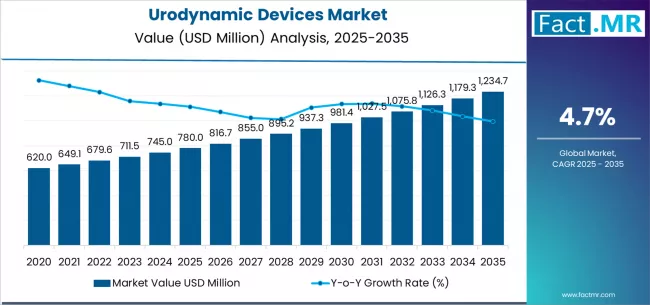
Between 2025 and 2030, the urodynamic devices market is projected to expand from USD 780 million to USD 990 million, resulting in a value increase of USD 210.0 million, which represents 46.7% of the total forecast growth for the decade. This phase of development will be shaped by increasing urological awareness recovery, rising diagnostic procedure adoption, and growing implementation of advanced testing solutions in healthcare operations. Device manufacturers are expanding their production capabilities to address the growing demand for precise diagnostic solutions and enhanced clinical reliability.
Urodynamic Devices Market Key Takeaways
| Metric | Value |
|---|---|
| Estimated Value in (2025E) | USD 780 million |
| Forecast Value in (2035F) | USD 1,230 million |
| Forecast CAGR (2025 to 2035) | 4.7% |
From 2030 to 2035, the market is forecast to grow from USD 990.0 million to USD 1,230 million, adding another USD 240.0 million, which constitutes 53.3% of the overall ten-year expansion. This period is expected to be characterized by the expansion of AI-powered diagnostic systems, the integration of digital health platforms, and the development of portable testing technologies for specialized healthcare facilities. The growing adoption of telemedicine programs and remote monitoring initiatives will drive demand for urodynamic devices with enhanced connectivity capabilities and improved diagnostic accuracy.
Between 2020 and 2025, the urodynamic devices market experienced steady recovery growth, driven by increasing urological disorder awareness and growing recognition of urodynamic testing as essential diagnostic procedure for bladder function assessment and treatment planning. The market developed as healthcare providers and urologists recognized the potential for advanced devices to enhance diagnostic precision while improving patient outcomes and clinical decision-making. Technological advancement in sensor technologies and digital integration began emphasizing the critical importance of maintaining diagnostic accuracy and operational efficiency in urological healthcare operations.
Why is the Urodynamic Devices Market Growing?
Market expansion is being supported by the increasing global aging population and the corresponding need for advanced diagnostic equipment that can maintain clinical accuracy and treatment guidance while supporting diverse urological healthcare applications across various medical environments. Modern healthcare providers and urology specialists are increasingly focused on implementing diagnostic solutions that can improve patient assessment, reduce diagnostic uncertainty, and provide consistent performance in urological evaluation procedures. Urodynamic devices' proven ability to deliver enhanced diagnostic precision, reliable clinical capabilities, and versatile healthcare applications make them essential equipment for contemporary urological operations and medical diagnostic solutions.
The growing emphasis on healthcare modernization and diagnostic efficiency is driving demand for urodynamic devices that can support comprehensive patient evaluation, reduce diagnostic delays, and enable efficient treatment planning across varying healthcare configurations. Healthcare provider preference for equipment that combines accuracy with clinical utility and cost-effectiveness is creating opportunities for innovative diagnostic implementations. The rising influence of evidence-based medicine and precision healthcare is also contributing to increased adoption of urodynamic devices that can provide advanced diagnostic capabilities without compromising performance or clinical reliability.
Opportunity Pathways - Urodynamic Devices Market
The urodynamic devices market is poised for robust growth and transformation. As healthcare providers and urology specialists across both developed and emerging markets seek diagnostic equipment that is accurate, efficient, portable, and clinically integrated, urodynamic systems are gaining prominence not just as diagnostic tools but as strategic solutions for patient care optimization, clinical efficiency, treatment planning enhancement, and healthcare quality improvement.
Rising urological disorder prevalence and healthcare modernization in North America, Europe, and Asia Pacific amplify demand, while manufacturers are picking up on innovations in sensor technologies and AI integration.
Pathways like AI-powered diagnostics, portable systems, and telemedicine integration promise strong margin uplift, especially in developed markets. Geographic expansion and application diversification will capture volume, particularly where urological care is expanding or diagnostic infrastructure requires modernization. Healthcare quality pressures around diagnostic accuracy, treatment outcomes, clinical efficiency, and patient satisfaction give structural support.
- Pathway A - AI-Powered & Advanced Analytics. Healthcare providers increasingly require devices with artificial intelligence and predictive analytics capabilities. Device manufacturers who specialize in AI integration or enhance analytical capabilities can command a premium. Expected revenue pool: USD 95-115 million
- Pathway B - Portable & Point-of-Care Solutions. Compact diagnostic systems - mobile testing, bedside capabilities, clinic integration - improve accessibility and reduce procedural complexity. Opportunity: USD 80-100 million
- Pathway C - Telemedicine & Remote Monitoring. Digital connectivity, remote data transmission, and virtual consultation support optimize patient care and enhance clinical workflow. Systems with stronger digital integration will allow premium positioning. Revenue lift: USD 65-85 million
- Pathway D - Specialized Clinical Applications. Extending reach into pediatric urology, neurourology, and research applications. Healthcare facilities will look for device suppliers who provide specialized, reliable diagnostic solutions. Pool: USD 70-90 million
- Pathway E - Emerging Market Expansion. Strong growth in developing healthcare markets, medical infrastructure development, and urology specialty expansion. Local partnerships and training programs help penetration. Expected upside: USD 55-75 million
- Pathway F - Comprehensive Service Solutions. Training services, technical support, and maintenance programs help healthcare providers optimize device utilization and clinical outcomes. Service approaches benefit from long-term relationships. USD 45-65 million
- Pathway G - Quality Enhancement Technologies. Improved sensors, enhanced software, and better user interfaces create differentiation and clinical performance advantages. Pool: USD 35-55 million
Segmental Analysis
The market is segmented by test, end user, and component. By test, the market is divided into uroflowmetry, cystometry, and pressure-flow & others. By end user, it covers hospitals, specialty urology centers, and ambulatory clinics. By component, it is segmented into systems, disposables, and software/analytics. Regionally, the market is divided into North America, Europe, Asia Pacific, Latin America, and Middle East & Africa.
By Test, the Uroflowmetry Segment Accounts for 38% Market Share
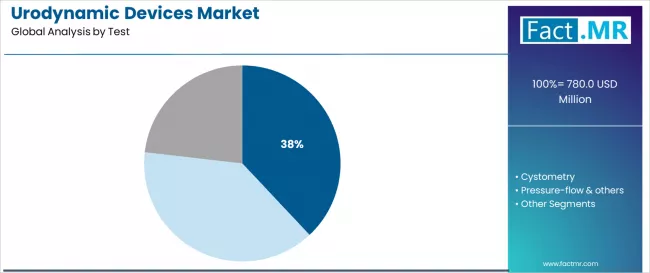
The uroflowmetry segment is projected to account for 38% of the urodynamic devices market in 2025, reaffirming its position as the leading test category. Healthcare providers and urology specialists increasingly utilize uroflowmetry testing for its proven simplicity, established diagnostic reliability, and non-invasive nature in urological assessment across patient evaluation, treatment planning, and follow-up monitoring applications. Uroflowmetry technology's established testing procedures and consistent diagnostic output directly address the clinical requirements for reliable urological screening and patient assessment in diverse healthcare environments.
This test segment forms the foundation of current urological diagnostics, as it represents the procedure with the greatest clinical accessibility and established implementation infrastructure across multiple healthcare settings and patient scenarios. Healthcare investments in enhanced flow measurement systems and diagnostic optimization continue to strengthen adoption among urologists and healthcare facilities. With providers prioritizing diagnostic accessibility and patient comfort, uroflowmetry testing aligns with both clinical effectiveness objectives and patient care requirements, making it the central component of comprehensive urological assessment strategies.
By End User, the Hospitals Segment Accounts for 57% Market Share
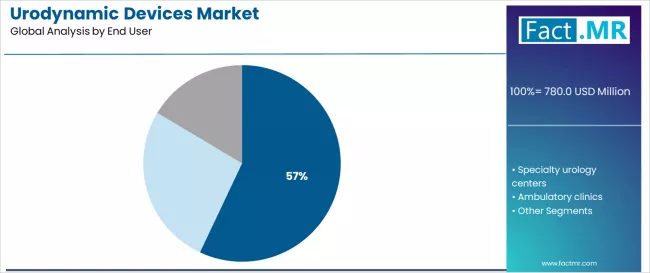
Hospitals are projected to represent 57% of urodynamic devices utilization in 2025, underscoring their critical role as the primary healthcare setting for comprehensive urological diagnostics and patient care. Hospitals prefer urodynamic devices for their comprehensive capabilities, established clinical protocols, and ability to support complex patient cases while maintaining diagnostic accuracy and treatment planning requirements. Positioned as essential diagnostic infrastructure for modern healthcare systems, hospitals offer both clinical advantages and patient care benefits.
The segment is supported by continuous innovation in hospital infrastructure and the growing availability of specialized diagnostic configurations that enable comprehensive testing with enhanced clinical capabilities. Hospitals are investing in equipment modernization to support large-scale operations and specialized care delivery. As healthcare complexity becomes more prevalent and diagnostic requirements increase, hospitals will continue to dominate the end user market while supporting advanced diagnostic protocols and patient care strategies.
By Component, the Systems Segment Accounts for 54% Market Share
Systems components are projected to represent 54% of urodynamic devices demand in 2025, underscoring their critical role as the primary equipment requirement for diagnostic functionality and clinical operation. Healthcare providers prefer urodynamic systems for their comprehensive capabilities, established diagnostic performance, and reliable operation in clinical testing while supporting patient assessment and treatment planning requirements. Positioned as essential equipment for modern urological diagnostics, systems offer both functional advantages and clinical benefits.
The segment is supported by continuous innovation in system technology and the growing availability of advanced diagnostic features that enable enhanced testing with improved clinical performance. Additionally, healthcare providers are investing in system optimization to support diagnostic accuracy and operational efficiency. As diagnostic sophistication becomes more prevalent and clinical requirements increase, systems will continue to dominate the component market while supporting advanced diagnostic capabilities and healthcare quality strategies.
What are the Drivers, Restraints, and Key Trends of the Urodynamic Devices Market?
The urodynamic devices market is advancing steadily due to increasing urological disorder prevalence and growing adoption of advanced diagnostic infrastructure that provides enhanced patient assessment and clinical decision-making across diverse healthcare applications. However, the market faces challenges, including device acquisition costs, specialized training requirements, and varying clinical protocols across different healthcare environments. Innovation in sensor technologies and digital integration continues to influence device development and market expansion patterns.
Rising Global Aging Population and Urological Disorder Prevalence
The growing expansion of aging demographics and urological health awareness is enabling device manufacturers to develop urodynamic systems that provide superior diagnostic accuracy, enhanced clinical capabilities, and reliable performance in specialized healthcare environments. Advanced diagnostic systems provide improved clinical capacity while allowing more effective patient assessment and consistent treatment planning across various applications and healthcare requirements. Manufacturers are increasingly recognizing the competitive advantages of modern diagnostic capabilities for clinical efficiency and healthcare provider positioning.
Digital Integration and AI Enhancement Drive Device Innovation
Modern urodynamic device manufacturers are incorporating artificial intelligence algorithms and digital connectivity features to enhance diagnostic precision, improve clinical workflow, and ensure consistent performance delivery to healthcare providers. These technologies improve clinical outcomes while enabling new applications, including remote monitoring and predictive analytics solutions. Advanced technology integration also allows manufacturers to support premium device positioning and clinical optimization beyond traditional diagnostic equipment supply.
Analysis of the Urodynamic Devices Market by Key Countries
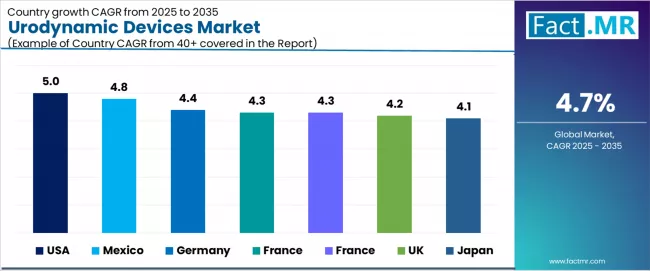
| Country | CAGR (2025-2035) |
|---|---|
| USA | 5.05 |
| Mexico | 4.8% |
| Germany | 4.4% |
| France | 4.3% |
| South Korea | 4.3% |
| United Kingdom | 4.2% |
| Japan | 4.1% |
The urodynamic devices market is experiencing steady growth globally, with the USA leading at a 5% CAGR through 2035, driven by extensive healthcare infrastructure development, advanced medical technology adoption, and significant implementation of AI-powered diagnostic solutions. Mexico follows at 4.8%, supported by growing healthcare investment, rapid medical infrastructure expansion, and growing adoption of advanced diagnostic technologies. Germany shows growth at 4.4%, emphasizing clinical excellence and advanced healthcare capabilities. France and South Korea record 4.3%, focusing on healthcare modernization and diagnostic optimization. United Kingdom demonstrates 4.2% growth, supported by healthcare system requirements and clinical modernization. Japan demonstrates 4.1% growth, supported by technology advancement but constrained by healthcare system constraints.
The report covers an in-depth analysis of 40+ countries top-performing countries are highlighted below.
USA Leads Global Market Growth with Healthcare Infrastructure Advancement
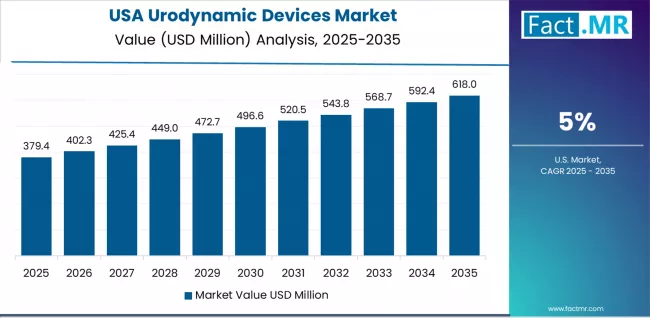
Revenue from urodynamic devices in the USA is projected to exhibit exceptional growth with a CAGR of 5.0% through 2035, driven by extensive healthcare infrastructure advancement and rapidly growing adoption of AI-powered diagnostic solutions supported by clinical innovation and quality initiatives. The country's comprehensive medical technology infrastructure and increasing investment in diagnostic optimization technologies are creating substantial demand for advanced urodynamic device solutions. Major healthcare systems and urology practices are establishing comprehensive diagnostic programs to serve both patient care operations and clinical research requirements.
- Strong healthcare investment and medical technology advancement is driving demand for sophisticated diagnostic technologies throughout major medical centers and specialty practices.
- Robust clinical research infrastructure and expanding network of urology centers are supporting the rapid adoption of advanced diagnostic technologies among providers seeking enhanced clinical accuracy and patient outcomes.
Mexico Demonstrates Strong Market Potential with Healthcare Infrastructure Expansion
Revenue from urodynamic devices in Mexico is expanding at a CAGR of 4.8%, supported by the country's growing healthcare investment, extensive medical infrastructure development, and increasing adoption of advanced diagnostic systems. The country's comprehensive healthcare modernization and expanding medical capabilities are driving sophisticated diagnostic requirements. Healthcare providers and medical institutions are establishing extensive diagnostic operations to address the growing demand for efficient urological assessment and clinical reliability.
- Rising healthcare infrastructure investment and expanding medical development are creating opportunities for device adoption across hospitals, clinics, and specialty centers in major metropolitan regions.
- Growing government focus on healthcare modernization and medical technology advancement is driving adoption of advanced diagnostic technologies among providers seeking enhanced clinical capabilities and patient care quality.
Europe Market Split by Countries
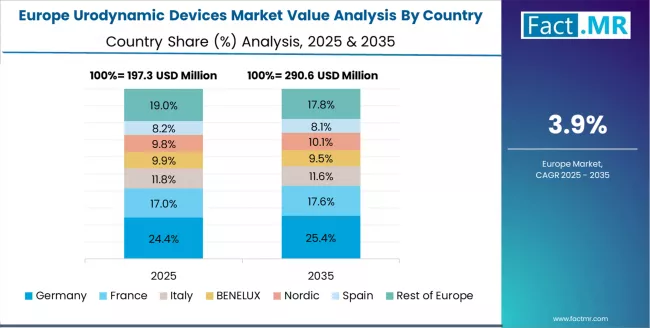
The urodynamic devices market in Europe is projected to grow from USD 220.0 million in 2025 to USD 325.0 million by 2035, registering a CAGR of 4.0% over the forecast period. Germany is expected to maintain its leadership position with a 31.8% market share in 2025, increasing to 32.4% by 2035, supported by its advanced healthcare infrastructure, comprehensive clinical capabilities, and major medical centers serving European and international patients.
France follows with a 22.7% share in 2025, projected to ease to 22.2% by 2035, driven by healthcare excellence programs, clinical innovation initiatives, and established medical capabilities, but facing challenges from competitive pressures and healthcare cost constraints. United Kingdom holds a 19.5% share in 2025, expected to decline to 19.1% by 2035, supported by healthcare system requirements and clinical modernization but facing challenges from healthcare funding limitations and system constraints. Italy commands a 13.6% share in 2025, projected to reach 13.8% by 2035, while Spain accounts for 9.1% in 2025, expected to reach 9.2% by 2035. The Rest of Europe region, including Nordic countries, Eastern European markets, Netherlands, Belgium, and other European countries, is anticipated to gain momentum, expanding its collective share from 3.3% to 3.3% by 2035, attributed to increasing healthcare development across Nordic countries and growing medical modernization across various European markets implementing diagnostic upgrade programs.
Competitive Landscape of the Urodynamic Devices Market
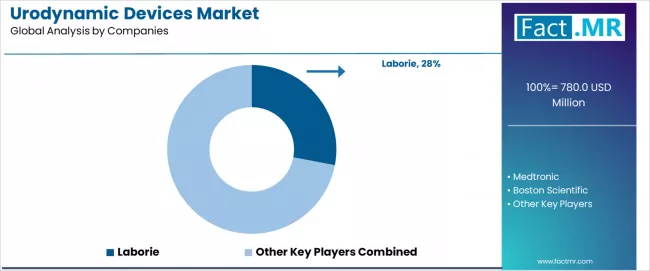
The urodynamic devices market is characterized by competition among established medical device manufacturers, specialized urology technology providers, and integrated healthcare solution companies. Companies are investing in advanced sensor research, AI technology development, clinical software optimization, and comprehensive device portfolios to deliver accurate, reliable, and clinically integrated urodynamic solutions. Innovation in diagnostic algorithms, connectivity features, and user interface capabilities is central to strengthening market position and competitive advantage.
Laborie leads the market with a 28.0% market share, offering specialized urodynamic devices with a focus on clinical accuracy and comprehensive diagnostic design for healthcare operations. Medtronic provides broad medical device portfolios with an emphasis on innovation, clinical integration, and global healthcare services. Boston Scientific delivers diverse medical technologies with a focus on clinical effectiveness and international market capabilities. CooperSurgical specializes in women's health solutions with emphasis on clinical specialization and diagnostic optimization. Dantec Dynamics/Albyn focuses on neurophysiology diagnostics with regional market leadership and specialized applications. MMS offers urodynamic solutions with European operations and clinical expertise. Verathon provides specialized diagnostic devices with emphasis on clinical accuracy and user-friendly design.
Key Players in the Urodynamic Devices Market
- Laborie
- Medtronic
- Boston Scientific
- CooperSurgical
- Dantec Dynamics/Albyn
- MMS
- Verathon
- MEDKON
- Red Leaf
- Andromeda
Scope of the Report
| Items | Values |
|---|---|
| Quantitative Units (2025) | USD 780 million |
| Test Type | Uroflowmetry, Cystometry, Pressure-flow & others |
| End User | Hospitals, Specialty urology centers, Ambulatory clinics |
| Component | Systems, Disposables, Software/analytics |
| Regions Covered | North America, Europe, Asia Pacific, Latin America, Middle East & Africa |
| Countries Covered | United States, Canada, Germany, United Kingdom, France, China, Japan, Brazil, India and 40+ countries |
| Key Companies Profiled | Laborie, Medtronic, Boston Scientific, CooperSurgical, Dantec Dynamics/Albyn, MMS, and Verathon |
| Additional Attributes | Device sales by test and end user category, regional demand trends, competitive landscape, technological advancements in diagnostic systems, AI development, clinical innovation, and healthcare integration optimization |
Urodynamic Devices Market by Segments
-
Test :
- Uroflowmetry
- Cystometry
- Pressure-flow & others
-
End User :
- Hospitals
- Specialty urology centers
- Ambulatory clinics
-
Component :
- Systems
- Disposables
- Software/analytics
-
Region :
-
North America
- United States
- Canada
- Mexico
-
Europe
- Germany
- United Kingdom
- France
- Italy
- Spain
- Nordic
- BENELUX
- Rest of Europe
-
Asia Pacific
- China
- Japan
- India
- South Korea
- ASEAN
- Australia & New Zealand
- Rest of Asia Pacific
-
Latin America
- Brazil
- Chile
- Rest of Latin America
-
Middle East & Africa
- Kingdom of Saudi Arabia
- Other GCC Countries
- Turkey
- South Africa
- Other African Union
- Rest of Middle East & Africa
-
Table of Content
- Executive Summary
- Global Market Outlook
- Demand to side Trends
- Supply to side Trends
- Technology Roadmap Analysis
- Analysis and Recommendations
- Market Overview
- Market Coverage / Taxonomy
- Market Definition / Scope / Limitations
- Market Background
- Market Dynamics
- Drivers
- Restraints
- Opportunity
- Trends
- Scenario Forecast
- Demand in Optimistic Scenario
- Demand in Likely Scenario
- Demand in Conservative Scenario
- Opportunity Map Analysis
- Product Life Cycle Analysis
- Supply Chain Analysis
- Investment Feasibility Matrix
- Value Chain Analysis
- PESTLE and Porter’s Analysis
- Regulatory Landscape
- Regional Parent Market Outlook
- Production and Consumption Statistics
- Import and Export Statistics
- Market Dynamics
- Global Market Analysis 2020 to 2024 and Forecast, 2025 to 2035
- Historical Market Size Value (USD Million) Analysis, 2020 to 2024
- Current and Future Market Size Value (USD Million) Projections, 2025 to 2035
- Y to o to Y Growth Trend Analysis
- Absolute $ Opportunity Analysis
- Global Market Pricing Analysis 2020 to 2024 and Forecast 2025 to 2035
- Global Market Analysis 2020 to 2024 and Forecast 2025 to 2035, By Test
- Introduction / Key Findings
- Historical Market Size Value (USD Million) Analysis By Test , 2020 to 2024
- Current and Future Market Size Value (USD Million) Analysis and Forecast By Test , 2025 to 2035
- Uroflowmetry
- Cystometry
- Pressure-flow & others
- Y to o to Y Growth Trend Analysis By Test , 2020 to 2024
- Absolute $ Opportunity Analysis By Test , 2025 to 2035
- Global Market Analysis 2020 to 2024 and Forecast 2025 to 2035, By End User
- Introduction / Key Findings
- Historical Market Size Value (USD Million) Analysis By End User, 2020 to 2024
- Current and Future Market Size Value (USD Million) Analysis and Forecast By End User, 2025 to 2035
- Hospitals
- Specialty urology centers
- Ambulatory clinics
- Y to o to Y Growth Trend Analysis By End User, 2020 to 2024
- Absolute $ Opportunity Analysis By End User, 2025 to 2035
- Global Market Analysis 2020 to 2024 and Forecast 2025 to 2035, By Region
- Introduction
- Historical Market Size Value (USD Million) Analysis By Region, 2020 to 2024
- Current Market Size Value (USD Million) Analysis and Forecast By Region, 2025 to 2035
- North America
- Latin America
- Western Europe
- Eastern Europe
- East Asia
- South Asia and Pacific
- Middle East & Africa
- Market Attractiveness Analysis By Region
- North America Market Analysis 2020 to 2024 and Forecast 2025 to 2035, By Country
- Historical Market Size Value (USD Million) Trend Analysis By Market Taxonomy, 2020 to 2024
- Market Size Value (USD Million) Forecast By Market Taxonomy, 2025 to 2035
- By Country
- USA
- Canada
- Mexico
- By Test
- By End User
- By Country
- Market Attractiveness Analysis
- By Country
- By Test
- By End User
- Key Takeaways
- Latin America Market Analysis 2020 to 2024 and Forecast 2025 to 2035, By Country
- Historical Market Size Value (USD Million) Trend Analysis By Market Taxonomy, 2020 to 2024
- Market Size Value (USD Million) Forecast By Market Taxonomy, 2025 to 2035
- By Country
- Brazil
- Chile
- Rest of Latin America
- By Test
- By End User
- By Country
- Market Attractiveness Analysis
- By Country
- By Test
- By End User
- Key Takeaways
- Western Europe Market Analysis 2020 to 2024 and Forecast 2025 to 2035, By Country
- Historical Market Size Value (USD Million) Trend Analysis By Market Taxonomy, 2020 to 2024
- Market Size Value (USD Million) Forecast By Market Taxonomy, 2025 to 2035
- By Country
- Germany
- UK
- Italy
- Spain
- France
- Nordic
- BENELUX
- Rest of Western Europe
- By Test
- By End User
- By Country
- Market Attractiveness Analysis
- By Country
- By Test
- By End User
- Key Takeaways
- Eastern Europe Market Analysis 2020 to 2024 and Forecast 2025 to 2035, By Country
- Historical Market Size Value (USD Million) Trend Analysis By Market Taxonomy, 2020 to 2024
- Market Size Value (USD Million) Forecast By Market Taxonomy, 2025 to 2035
- By Country
- Russia
- Poland
- Hungary
- Balkan & Baltic
- Rest of Eastern Europe
- By Test
- By End User
- By Country
- Market Attractiveness Analysis
- By Country
- By Test
- By End User
- Key Takeaways
- East Asia Market Analysis 2020 to 2024 and Forecast 2025 to 2035, By Country
- Historical Market Size Value (USD Million) Trend Analysis By Market Taxonomy, 2020 to 2024
- Market Size Value (USD Million) Forecast By Market Taxonomy, 2025 to 2035
- By Country
- China
- Japan
- South Korea
- By Test
- By End User
- By Country
- Market Attractiveness Analysis
- By Country
- By Test
- By End User
- Key Takeaways
- South Asia and Pacific Market Analysis 2020 to 2024 and Forecast 2025 to 2035, By Country
- Historical Market Size Value (USD Million) Trend Analysis By Market Taxonomy, 2020 to 2024
- Market Size Value (USD Million) Forecast By Market Taxonomy, 2025 to 2035
- By Country
- India
- ASEAN
- Australia & New Zealand
- Rest of South Asia and Pacific
- By Test
- By End User
- By Country
- Market Attractiveness Analysis
- By Country
- By Test
- By End User
- Key Takeaways
- Middle East & Africa Market Analysis 2020 to 2024 and Forecast 2025 to 2035, By Country
- Historical Market Size Value (USD Million) Trend Analysis By Market Taxonomy, 2020 to 2024
- Market Size Value (USD Million) Forecast By Market Taxonomy, 2025 to 2035
- By Country
- Kingdom of Saudi Arabia
- Other GCC Countries
- Turkiye
- South Africa
- Other African Union
- Rest of Middle East & Africa
- By Test
- By End User
- By Country
- Market Attractiveness Analysis
- By Country
- By Test
- By End User
- Key Takeaways
- Key Countries Market Analysis
- USA
- Pricing Analysis
- Market Share Analysis, 2024
- By Test
- By End User
- Canada
- Pricing Analysis
- Market Share Analysis, 2024
- By Test
- By End User
- Mexico
- Pricing Analysis
- Market Share Analysis, 2024
- By Test
- By End User
- Brazil
- Pricing Analysis
- Market Share Analysis, 2024
- By Test
- By End User
- Chile
- Pricing Analysis
- Market Share Analysis, 2024
- By Test
- By End User
- Germany
- Pricing Analysis
- Market Share Analysis, 2024
- By Test
- By End User
- UK
- Pricing Analysis
- Market Share Analysis, 2024
- By Test
- By End User
- Italy
- Pricing Analysis
- Market Share Analysis, 2024
- By Test
- By End User
- Spain
- Pricing Analysis
- Market Share Analysis, 2024
- By Test
- By End User
- France
- Pricing Analysis
- Market Share Analysis, 2024
- By Test
- By End User
- India
- Pricing Analysis
- Market Share Analysis, 2024
- By Test
- By End User
- ASEAN
- Pricing Analysis
- Market Share Analysis, 2024
- By Test
- By End User
- Australia & New Zealand
- Pricing Analysis
- Market Share Analysis, 2024
- By Test
- By End User
- China
- Pricing Analysis
- Market Share Analysis, 2024
- By Test
- By End User
- Japan
- Pricing Analysis
- Market Share Analysis, 2024
- By Test
- By End User
- South Korea
- Pricing Analysis
- Market Share Analysis, 2024
- By Test
- By End User
- Russia
- Pricing Analysis
- Market Share Analysis, 2024
- By Test
- By End User
- Poland
- Pricing Analysis
- Market Share Analysis, 2024
- By Test
- By End User
- Hungary
- Pricing Analysis
- Market Share Analysis, 2024
- By Test
- By End User
- Kingdom of Saudi Arabia
- Pricing Analysis
- Market Share Analysis, 2024
- By Test
- By End User
- Turkiye
- Pricing Analysis
- Market Share Analysis, 2024
- By Test
- By End User
- South Africa
- Pricing Analysis
- Market Share Analysis, 2024
- By Test
- By End User
- USA
- Market Structure Analysis
- Competition Dashboard
- Competition Benchmarking
- Market Share Analysis of Top Players
- By Regional
- By Test
- By End User
- Competition Analysis
- Competition Deep Dive
- Laborie
- Overview
- Product Portfolio
- Profitability by Market Segments (Product/Age /Sales Channel/Region)
- Sales Footprint
- Strategy Overview
- Marketing Strategy
- Product Strategy
- Channel Strategy
- Medtronic
- Boston Scientific
- CooperSurgical
- Dantec Dynamics/Albyn
- MMS
- Verathon
- MEDKON
- Red Leaf
- Andromeda
- Laborie
- Competition Deep Dive
- Assumptions & Acronyms Used
- Research Methodology
List Of Table
- Table 1: Global Market Value (USD Million) Forecast by Region, 2020 to 2035
- Table 2: Global Market Value (USD Million) Forecast by Test , 2020 to 2035
- Table 3: Global Market Value (USD Million) Forecast by End User, 2020 to 2035
- Table 4: North America Market Value (USD Million) Forecast by Country, 2020 to 2035
- Table 5: North America Market Value (USD Million) Forecast by Test , 2020 to 2035
- Table 6: North America Market Value (USD Million) Forecast by End User, 2020 to 2035
- Table 7: Latin America Market Value (USD Million) Forecast by Country, 2020 to 2035
- Table 8: Latin America Market Value (USD Million) Forecast by Test , 2020 to 2035
- Table 9: Latin America Market Value (USD Million) Forecast by End User, 2020 to 2035
- Table 10: Western Europe Market Value (USD Million) Forecast by Country, 2020 to 2035
- Table 11: Western Europe Market Value (USD Million) Forecast by Test , 2020 to 2035
- Table 12: Western Europe Market Value (USD Million) Forecast by End User, 2020 to 2035
- Table 13: Eastern Europe Market Value (USD Million) Forecast by Country, 2020 to 2035
- Table 14: Eastern Europe Market Value (USD Million) Forecast by Test , 2020 to 2035
- Table 15: Eastern Europe Market Value (USD Million) Forecast by End User, 2020 to 2035
- Table 16: East Asia Market Value (USD Million) Forecast by Country, 2020 to 2035
- Table 17: East Asia Market Value (USD Million) Forecast by Test , 2020 to 2035
- Table 18: East Asia Market Value (USD Million) Forecast by End User, 2020 to 2035
- Table 19: South Asia and Pacific Market Value (USD Million) Forecast by Country, 2020 to 2035
- Table 20: South Asia and Pacific Market Value (USD Million) Forecast by Test , 2020 to 2035
- Table 21: South Asia and Pacific Market Value (USD Million) Forecast by End User, 2020 to 2035
- Table 22: Middle East & Africa Market Value (USD Million) Forecast by Country, 2020 to 2035
- Table 23: Middle East & Africa Market Value (USD Million) Forecast by Test , 2020 to 2035
- Table 24: Middle East & Africa Market Value (USD Million) Forecast by End User, 2020 to 2035
List Of Figures
- Figure 1: Global Market Pricing Analysis
- Figure 2: Global Market Value (USD Million) Forecast 2020-2035
- Figure 3: Global Market Value Share and BPS Analysis by Test , 2025 and 2035
- Figure 4: Global Market Y to o to Y Growth Comparison by Test , 2025-2035
- Figure 5: Global Market Attractiveness Analysis by Test
- Figure 6: Global Market Value Share and BPS Analysis by End User, 2025 and 2035
- Figure 7: Global Market Y to o to Y Growth Comparison by End User, 2025-2035
- Figure 8: Global Market Attractiveness Analysis by End User
- Figure 9: Global Market Value (USD Million) Share and BPS Analysis by Region, 2025 and 2035
- Figure 10: Global Market Y to o to Y Growth Comparison by Region, 2025-2035
- Figure 11: Global Market Attractiveness Analysis by Region
- Figure 12: North America Market Incremental Dollar Opportunity, 2025-2035
- Figure 13: Latin America Market Incremental Dollar Opportunity, 2025-2035
- Figure 14: Western Europe Market Incremental Dollar Opportunity, 2025-2035
- Figure 15: Eastern Europe Market Incremental Dollar Opportunity, 2025-2035
- Figure 16: East Asia Market Incremental Dollar Opportunity, 2025-2035
- Figure 17: South Asia and Pacific Market Incremental Dollar Opportunity, 2025-2035
- Figure 18: Middle East & Africa Market Incremental Dollar Opportunity, 2025-2035
- Figure 19: North America Market Value Share and BPS Analysis by Country, 2025 and 2035
- Figure 20: North America Market Value Share and BPS Analysis by Test , 2025 and 2035
- Figure 21: North America Market Y to o to Y Growth Comparison by Test , 2025-2035
- Figure 22: North America Market Attractiveness Analysis by Test
- Figure 23: North America Market Value Share and BPS Analysis by End User, 2025 and 2035
- Figure 24: North America Market Y to o to Y Growth Comparison by End User, 2025-2035
- Figure 25: North America Market Attractiveness Analysis by End User
- Figure 26: Latin America Market Value Share and BPS Analysis by Country, 2025 and 2035
- Figure 27: Latin America Market Value Share and BPS Analysis by Test , 2025 and 2035
- Figure 28: Latin America Market Y to o to Y Growth Comparison by Test , 2025-2035
- Figure 29: Latin America Market Attractiveness Analysis by Test
- Figure 30: Latin America Market Value Share and BPS Analysis by End User, 2025 and 2035
- Figure 31: Latin America Market Y to o to Y Growth Comparison by End User, 2025-2035
- Figure 32: Latin America Market Attractiveness Analysis by End User
- Figure 33: Western Europe Market Value Share and BPS Analysis by Country, 2025 and 2035
- Figure 34: Western Europe Market Value Share and BPS Analysis by Test , 2025 and 2035
- Figure 35: Western Europe Market Y to o to Y Growth Comparison by Test , 2025-2035
- Figure 36: Western Europe Market Attractiveness Analysis by Test
- Figure 37: Western Europe Market Value Share and BPS Analysis by End User, 2025 and 2035
- Figure 38: Western Europe Market Y to o to Y Growth Comparison by End User, 2025-2035
- Figure 39: Western Europe Market Attractiveness Analysis by End User
- Figure 40: Eastern Europe Market Value Share and BPS Analysis by Country, 2025 and 2035
- Figure 41: Eastern Europe Market Value Share and BPS Analysis by Test , 2025 and 2035
- Figure 42: Eastern Europe Market Y to o to Y Growth Comparison by Test , 2025-2035
- Figure 43: Eastern Europe Market Attractiveness Analysis by Test
- Figure 44: Eastern Europe Market Value Share and BPS Analysis by End User, 2025 and 2035
- Figure 45: Eastern Europe Market Y to o to Y Growth Comparison by End User, 2025-2035
- Figure 46: Eastern Europe Market Attractiveness Analysis by End User
- Figure 47: East Asia Market Value Share and BPS Analysis by Country, 2025 and 2035
- Figure 48: East Asia Market Value Share and BPS Analysis by Test , 2025 and 2035
- Figure 49: East Asia Market Y to o to Y Growth Comparison by Test , 2025-2035
- Figure 50: East Asia Market Attractiveness Analysis by Test
- Figure 51: East Asia Market Value Share and BPS Analysis by End User, 2025 and 2035
- Figure 52: East Asia Market Y to o to Y Growth Comparison by End User, 2025-2035
- Figure 53: East Asia Market Attractiveness Analysis by End User
- Figure 54: South Asia and Pacific Market Value Share and BPS Analysis by Country, 2025 and 2035
- Figure 55: South Asia and Pacific Market Value Share and BPS Analysis by Test , 2025 and 2035
- Figure 56: South Asia and Pacific Market Y to o to Y Growth Comparison by Test , 2025-2035
- Figure 57: South Asia and Pacific Market Attractiveness Analysis by Test
- Figure 58: South Asia and Pacific Market Value Share and BPS Analysis by End User, 2025 and 2035
- Figure 59: South Asia and Pacific Market Y to o to Y Growth Comparison by End User, 2025-2035
- Figure 60: South Asia and Pacific Market Attractiveness Analysis by End User
- Figure 61: Middle East & Africa Market Value Share and BPS Analysis by Country, 2025 and 2035
- Figure 62: Middle East & Africa Market Value Share and BPS Analysis by Test , 2025 and 2035
- Figure 63: Middle East & Africa Market Y to o to Y Growth Comparison by Test , 2025-2035
- Figure 64: Middle East & Africa Market Attractiveness Analysis by Test
- Figure 65: Middle East & Africa Market Value Share and BPS Analysis by End User, 2025 and 2035
- Figure 66: Middle East & Africa Market Y to o to Y Growth Comparison by End User, 2025-2035
- Figure 67: Middle East & Africa Market Attractiveness Analysis by End User
- Figure 68: Global Market - Tier Structure Analysis
- Figure 69: Global Market - Company Share Analysis
- FAQs -
How big is the urodynamic devices market in 2025?
The global urodynamic devices market is estimated to be valued at USD 780.0 million in 2025.
What will be the size of urodynamic devices market in 2035?
The market size for the urodynamic devices market is projected to reach USD 1,234.7 million by 2035.
How much will be the urodynamic devices market growth between 2025 and 2035?
The urodynamic devices market is expected to grow at a 4.7% CAGR between 2025 and 2035.
What are the key product types in the urodynamic devices market?
The key product types in urodynamic devices market are uroflowmetry, cystometry and pressure-flow & others.
Which end user segment to contribute significant share in the urodynamic devices market in 2025?
In terms of end user, hospitals segment to command 57.0% share in the urodynamic devices market in 2025.